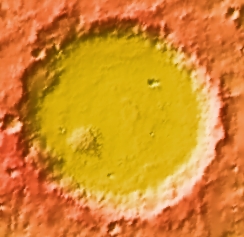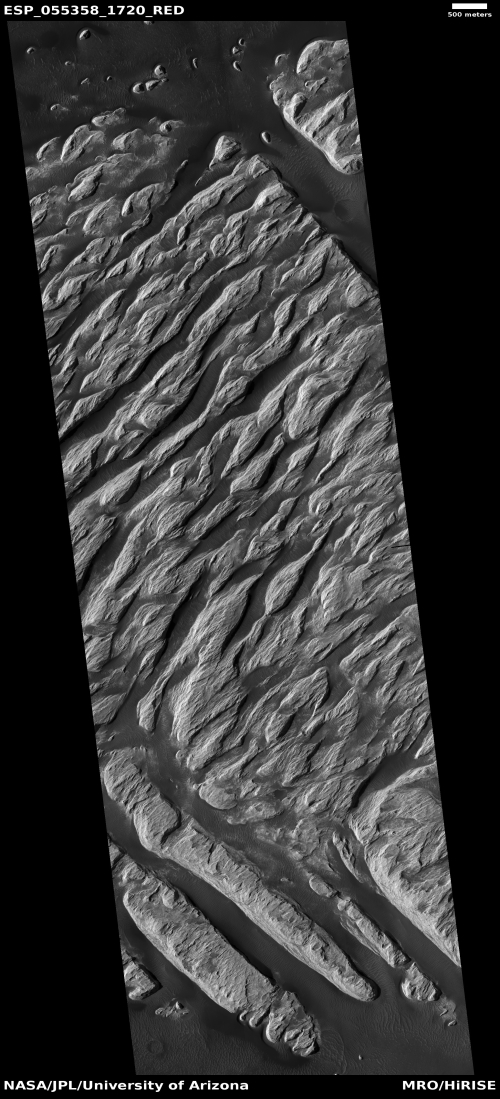A strange bulge on Mars

Cool image time! The image on the right is not the cool image, but a context image of 59-mile-wide Pollack Crater, located slightly south of the Martian equator in the planet’s southern cratered highlands. What makes this crater intriguing to planetary scientists, and has prompted them to take many images over the decades, is the bulge in the southwest part of the crater’s floor. You don’t normally see a rise off-center like this inside craters. If there were any peaks, you’d expect them to be in the center, formed during the impact, when the crater floor melts and acts more like water in a pond when you drop a pebble into it, forming ripples with an uplifting drop in the dead center.
It therefore isn’t surprising that planetary scientists have taken a lot of pictures of this bulge, going back to the Mariner 9 orbiter in 1972, which first discovered it. Scientists then dubbed it “White Rock” because in the first black & white images it looked much brighter than the surrounding terrain. Later color images revealed that it is actually somewhat reddish in color, not white. As noted at this Mars Global Surveyor webpage,

The layering in White Rock suggests that the material is sediment deposited at some time in the distant past within Pollack Crater. The fact that the material erodes to form steep cliffs suggests that it is hard like rock. Thus, White Rock is interpreted to be an outcrop of sedimentary rock. It is probably a small remnant of a larger body of rock that may have once covered the entire floor of Pollack Crater; this view is supported by the observation that more extensive layered rocks are seen in other craters across the surface of the red planet.
The image to the right was taken on May 19, 2018, was part of the July image release by the high resolution camera on Mars Reconnaissance Orbiter (MRO), and is almost identical to an earlier image taken by MRO in 2007. (I have cropped and reduced it to post here, and if you click on the image you can see the full resolution version.) I suspect some scientists are going to spend some time comparing the two to see if anything has changed during those eleven years.
All the images of White Rock suggest that this outcrop of harder sedimentary rock, exposed by erosion, is tilted relative to the surface. That the bulge is made up of a series of gigantic white ridges that are aligned in two different angles, from southwest to northeast on the north, and from northwest to southeast on the south, adds weight to this supposition, suggesting that the high point is to the west. This theory is further strengthened by this image at the bulge’s easternmost end, where the ridges appear to rise slowly up from the Martian dust. At the westernmost end, what should be the bulge’s high point, the bulge seems to end at roughly the place where the two oppositely aligned ridge angles come together.
Essentially, the ridges seem to form an anticline that is mostly lying on its side.
This theory however does not explain everything. For example, the need for erosion to expose this outcrop suggests that the entire floor of the crater was once much higher. Could it have been? Also, shouldn’t this bulge of ridges have experienced more deformation from the impact that created the crater? The large cross-cutting gully at the top of the image also raises questions about whether is really an anticline. We might be seeing another geological process caused by the unique Martian situation and its lower gravity that is not seen on Earth.
Ah, mysteries! I love them. It is what makes real science so fascinating.
On Christmas Eve 1968 three Americans became the first humans to visit another world. What they did to celebrate was unexpected and profound, and will be remembered throughout all human history. Genesis: the Story of Apollo 8, Robert Zimmerman's classic history of humanity's first journey to another world, tells that story, and it is now available as both an ebook and an audiobook, both with a foreword by Valerie Anders and a new introduction by Robert Zimmerman.
The print edition can be purchased at Amazon or from any other book seller. If you want an autographed copy the price is $60 for the hardback and $45 for the paperback, plus $8 shipping for each. Go here for purchasing details. The ebook is available everywhere for $5.99 (before discount) at amazon, or direct from my ebook publisher, ebookit. If you buy it from ebookit you don't support the big tech companies and the author gets a bigger cut much sooner.
The audiobook is also available at all these vendors, and is also free with a 30-day trial membership to Audible.
"Not simply about one mission, [Genesis] is also the history of America's quest for the moon... Zimmerman has done a masterful job of tying disparate events together into a solid account of one of America's greatest human triumphs."--San Antonio Express-News

Cool image time! The image on the right is not the cool image, but a context image of 59-mile-wide Pollack Crater, located slightly south of the Martian equator in the planet’s southern cratered highlands. What makes this crater intriguing to planetary scientists, and has prompted them to take many images over the decades, is the bulge in the southwest part of the crater’s floor. You don’t normally see a rise off-center like this inside craters. If there were any peaks, you’d expect them to be in the center, formed during the impact, when the crater floor melts and acts more like water in a pond when you drop a pebble into it, forming ripples with an uplifting drop in the dead center.
It therefore isn’t surprising that planetary scientists have taken a lot of pictures of this bulge, going back to the Mariner 9 orbiter in 1972, which first discovered it. Scientists then dubbed it “White Rock” because in the first black & white images it looked much brighter than the surrounding terrain. Later color images revealed that it is actually somewhat reddish in color, not white. As noted at this Mars Global Surveyor webpage,

The layering in White Rock suggests that the material is sediment deposited at some time in the distant past within Pollack Crater. The fact that the material erodes to form steep cliffs suggests that it is hard like rock. Thus, White Rock is interpreted to be an outcrop of sedimentary rock. It is probably a small remnant of a larger body of rock that may have once covered the entire floor of Pollack Crater; this view is supported by the observation that more extensive layered rocks are seen in other craters across the surface of the red planet.
The image to the right was taken on May 19, 2018, was part of the July image release by the high resolution camera on Mars Reconnaissance Orbiter (MRO), and is almost identical to an earlier image taken by MRO in 2007. (I have cropped and reduced it to post here, and if you click on the image you can see the full resolution version.) I suspect some scientists are going to spend some time comparing the two to see if anything has changed during those eleven years.
All the images of White Rock suggest that this outcrop of harder sedimentary rock, exposed by erosion, is tilted relative to the surface. That the bulge is made up of a series of gigantic white ridges that are aligned in two different angles, from southwest to northeast on the north, and from northwest to southeast on the south, adds weight to this supposition, suggesting that the high point is to the west. This theory is further strengthened by this image at the bulge’s easternmost end, where the ridges appear to rise slowly up from the Martian dust. At the westernmost end, what should be the bulge’s high point, the bulge seems to end at roughly the place where the two oppositely aligned ridge angles come together.
Essentially, the ridges seem to form an anticline that is mostly lying on its side.
This theory however does not explain everything. For example, the need for erosion to expose this outcrop suggests that the entire floor of the crater was once much higher. Could it have been? Also, shouldn’t this bulge of ridges have experienced more deformation from the impact that created the crater? The large cross-cutting gully at the top of the image also raises questions about whether is really an anticline. We might be seeing another geological process caused by the unique Martian situation and its lower gravity that is not seen on Earth.
Ah, mysteries! I love them. It is what makes real science so fascinating.
On Christmas Eve 1968 three Americans became the first humans to visit another world. What they did to celebrate was unexpected and profound, and will be remembered throughout all human history. Genesis: the Story of Apollo 8, Robert Zimmerman's classic history of humanity's first journey to another world, tells that story, and it is now available as both an ebook and an audiobook, both with a foreword by Valerie Anders and a new introduction by Robert Zimmerman.
The print edition can be purchased at Amazon or from any other book seller. If you want an autographed copy the price is $60 for the hardback and $45 for the paperback, plus $8 shipping for each. Go here for purchasing details. The ebook is available everywhere for $5.99 (before discount) at amazon, or direct from my ebook publisher, ebookit. If you buy it from ebookit you don't support the big tech companies and the author gets a bigger cut much sooner.
The audiobook is also available at all these vendors, and is also free with a 30-day trial membership to Audible.
"Not simply about one mission, [Genesis] is also the history of America's quest for the moon... Zimmerman has done a masterful job of tying disparate events together into a solid account of one of America's greatest human triumphs."--San Antonio Express-News

